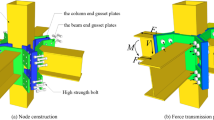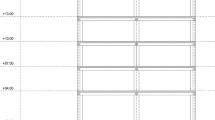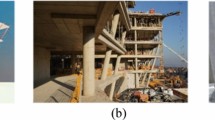Abstract
Steel plate shear walls (SPSWs) with low yield point (LYP) steel infill plates have been demonstrated in a number of studies to be efficient and promising lateral force-resisting and energy dissipating systems. In fact, use of LYP steel with extremely low yield stress and high elongation capacity compared to the conventional steel enables the employment of infill plates with improved buckling stability, serviceability, and damping characteristics. In contrast to the commonly-used slender and conventional steel plates with relatively low buckling and high yielding capacities, LYP steel plates can have low yielding and high buckling capacities due to the early yielding of the steel material. On this basis, this paper aims at evaluating the structural behavior and performance of SPSWs with unstiffened LYP steel infill plates designed per AISC 341 seismic provisions which typically address SPSWs with slender infill plates. Effects of plate aspect ratio, and combined compressive and shear forces acting on the web plate are also considered in this study. Numerical analysis of the code-designed LYP steel shear wall models demonstrates the efficient strength, stiffness, and cyclic performances of such systems. In addition, the effectiveness of some design requirements specified in AISC 341 code is evaluated based on the behavior of the SPSW components, and design recommendations are provided accordingly. Finally, a modified plate-frame interaction (PFI) method is used to predict and characterize the behavior of SPSW systems with low yielding and relatively high buckling capacities, the effectiveness of which is verified by comparing the predicted response with experimental and numerical results.
Similar content being viewed by others
References
AISC 341-05 (2005). Seismic provisions for structural steel buildings. American Institute of Steel Construction, Chicago, IL.
AISC 341-10 (2010). Seismic provisions for structural steel buildings. American Institute of Steel Construction, Chicago, IL.
AISC 358-10 (2010). Prequalified connections for special and intermediate steel moment frames for seismic applications. American Institute of Steel Construction, Chicago, IL.
AISC 360-10 (2010). Specification for structural steel buildings. American Institute of Steel Construction, Chicago, IL.
ANSYS 11.0 (2007). ANSYS 11.0 documentation. ANSYS Inc.
Behbahanifard, M. R., Grondin, G. Y., and Elwi, A. E. (2003). Experimental and numerical investigation of steel plate shear wall. Structural Engineering Report 254, Department of Civil and Environmental Engineering, University of Alberta, Canada.
Berman, J. W. (2011). “Seismic behavior of code designed steel plate shear walls.” Engineering Structures, 33(1), pp. 230–244.
Chen, S. J. and Jhang, C. (2006). “Cyclic behavior of low yield point steel shear walls.” Thin-Walled Structures, 44(7), pp. 730–738.
Chen S. J. and Jhang, C. (2011). “Experimental study of low-yield-point steel plate shear wall under in-plane load.” Journal of Constructional Steel Research, 67(6), pp. 977–985.
Chen, W. F., Yoshiaki, G., and Liew, J. Y. R. (1996). Stability design of semi-rigid frames. Vol. 1, John Wiley & Sons, Inc.
Chen, Y. Z., Lee, Y. Y., Li, Q. S., and Guo, Y. J. (2009). “Concise formula for the critical buckling stresses of an elastic plate under biaxial compression and shear.” Journal of Constructional Steel Research, 65(7), pp. 1507–1510.
De Matteis, G., Landolfo, R., and Mazzolani, F. M. (2003). “Seismic response of MR steel frames with low-yield steel shear panels.” Engineering Structures, 25(2), pp. 155–168.
Lubell, A. S. (1997). Performance of unstiffened steel plate shear walls under cyclic quasi-static loading. M.A.Sc. Thesis, Department of Civil Engineering, University of British Columbia, Canada.
Mistakidis, E. (2010). “Numerical study of low-yield point steel shear walls used for seismic applications.” Engineering Computations: International Journal for Computer-Aided Engineering and Software, 27(2), pp. 257–279.
Moslehi Tabar, A. and Deylami, A. (2005). “Instability of beams with reduced beam section moment connections emphasizing the effect of column panel zone ductility.” Journal of Constructional Steel Research, 61(11), pp. 1475–1491.
Nakagawa, S., Kihara, H., Torii, S., Nakata, Y., Iwata, M., Fujisawa, K., and Fukuda, K. (1996). “Hysteretic behavior of low yield strength steel panel shear wall — experimental investigation.” Proc. 11 th World Conference on Earthquake Engineering, Paper No. 171.
Nakashima, M. (1995). “Strain-hardening behavior of shear panels made of low-yield steel. I: Test.” Journal of Structural Engineering, ASCE, 121(12), pp. 1742–1749.
Sabelli, R. and Bruneau, M. (2006). Steel plate shear walls. Steel design guide 20, American Institute of Steel Construction, Chicago, IL.
Sabouri-Ghomi, S. and Roberts, T. M. (1992). “Nonlinear dynamic analysis of steel plate shear walls including shear and bending deformations.” Engineering Structures, 14(5), pp. 309–317.
Sabouri-Ghomi, S., Ventura, C. E., and Kharrazi, M. H. K. (2005). “Shear analysis and design of ductile steel plate walls.” Journal of Structural Engineering, ASCE, 131(6), pp. 878–889.
Saeki, E., Sugisawa, M., Yamaguchi, T., and Wada, A. (1998). “Mechanical properties of low-yield point steels.” Journal of Materials in Civil Engineering, ASCE, 10(3), pp. 143–152.
Seilie, I. F. and Hooper, J. D. (2005). “Steel plate shear walls: Practical design and construction.” North American Steel Construction Conference, Modern Steel Construction, AprIL.
Thorburn, L. J., Kulak, G. L., and Montgomery, C. J. (1983). Analysis of steel plate shear walls. Structural Engineering Report No. 107, Department of Civil Engineering, University of Alberta, Edmonton, Alberta, Canada.
Timler, P. A. and Kulak, G. L. (1983). Experimental study of steel plate shear walls. Structural Engineering Report No. 114, Department of Civil Engineering, University of Alberta, Edmonton, Alberta, Canada.
Timoshenko, S. P. and Gere, J. M. (1961). Theory of Elastic Stability. 2 nd Ed., McGraw-Hill, New York.
Topkaya, C. and Atasoy, M. (2009). “Lateral stiffness of steel plate shear wall systems.” Thin-Walled Structures, 47(8–9), pp. 827–835.
Torii, S., Teramoto, T., Kihara, H. and Kitamura, H. (1996). “The response control design of high-rise building with low yield steel wall.” Proc. 11 th World Conference on Earthquake Engineering, Paper No. 97.
Tsai, K. C. and Lin, Y. C. (2005). “Seismic performance of steel plate shear wall frames.” Proc. 4 th International Conference on Advances in Steel Structures, Sanghai, China.
Vian, D. and Bruneau, M. (2004). “Testing of special LYS steel plate shear walls.” Proc. 13 th World Conference on Earthquake Engineering, Vancouver, B.C., Canada.
Vian, D., Bruneau, M., Tsai, K. C., and Lin, Y. C. (2009). “Special perforated steel plate shear walls with reduced beam section anchor beams. I: Experimental investigation.” Journal of Structural Engineering, ASCE, 135(3), pp. 211–220.
Yamaguchi, T., Nakata, Y., Takeuchi, T., Ikebe, T., Nagao, T., Minami, A., and Suzuki, T. (1998). Seismic control devices using low-yield-point steel. Nippon Steel Technical Report No. 77, 78, pp. 65–72.
Author information
Authors and Affiliations
Corresponding author
Rights and permissions
About this article
Cite this article
Zirakian, T., Zhang, J. Seismic design and behavior of low yield point steel plate shear walls. Int J Steel Struct 15, 135–151 (2015). https://doi.org/10.1007/s13296-015-3010-8
Received:
Accepted:
Published:
Issue Date:
DOI: https://doi.org/10.1007/s13296-015-3010-8




